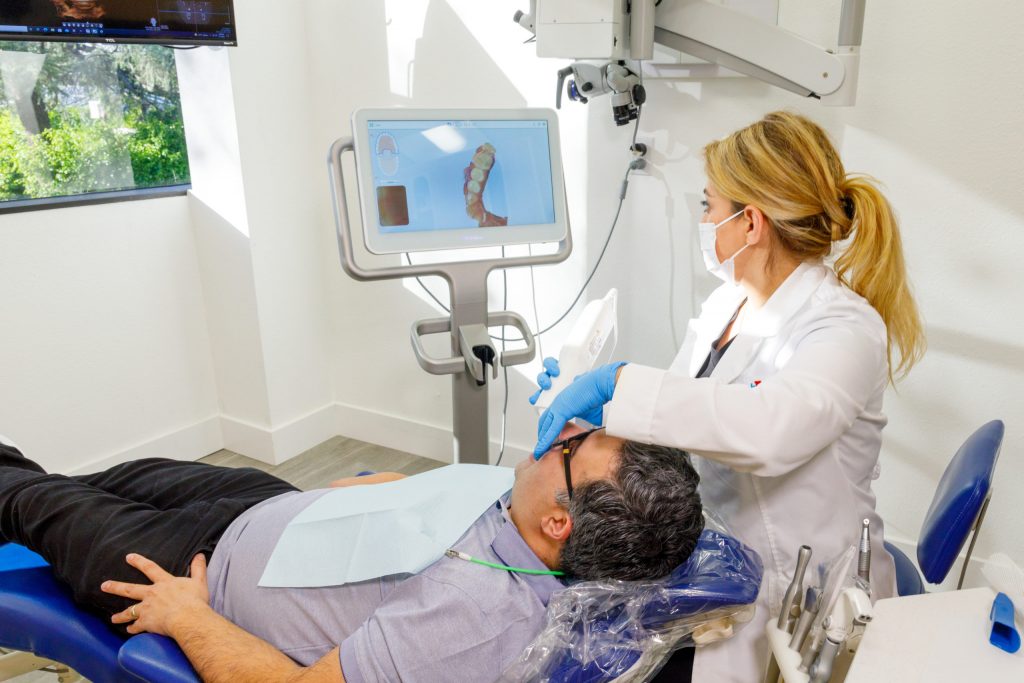Invisalign in Mission Hills, CA
With Invisalign, you may be able to get the smile you want in 6 months to a year.
First-Time Patient?
Consultation, Exam, X-Rays, and Regular Cleaning for only $250!
Online Booking
Invisalign Provider in Mission Hills, CA
Clear aligners are not only virtually undetectable but also extremely successful. With Invisalign, you may be able to get the smile you want in 6 months to a year. Our goal is to help every patient achieve beautiful and healthy smiles through a whole approach.
While traditional braces use harsh metal brackets, Invisalign is a gentler BPA-free plastic that causes lower strain to your body. As a result, Invisalign is a less invasive and healthier way to straighten teeth.
With Invisalign, you can gradually straighten your teeth without sacrificing your favorite foods. While metal braces require patients to avoid hard candies and sticky foods, clear plastic aligners are removable for meals, so you can eat whatever you want. In addition, because they are detachable, there is no fussy maintenance – just brush and floss as usual!
If you’re interested in straightening your teeth with clear aligners, call us at 818-766-7776.
Why Choose Invisalign over Braces?
- Clear aligners straighten your teeth without bulky metal brackets and wires.
- You can enjoy your favorite foods by taking out the aligners to eat.
- Clear aligners reduce the risk of awkward stains.
- You don’t have to add to or change your oral hygiene routine.
- Clear plastic aligners are more comfortable than traditional metal braces.
- Invisalign clear aligners are easy to clean.
- Invisalign plastic aligners are highly durable.
The clear aligner Treatment Procedure
Your clear aligners specialist will begin the process by taking a mold of your teeth. Clear aligners are designed to fit the unique shape and layout of your teeth for maximum comfort.
Once a plan of treatment is decided, you will be given several sets of aligners. Then, every ten days to 2 weeks, you will replace one aligner for the next, slowly moving your teeth to achieve the desired alignment.
How Long Does the Invisalign Treatment Last?
Although a clear aligner treatment requires less time than traditional metal braces, the length of time will depend on your situation. Most clear aligner treatments can straighten your teeth within a year; however, your Invisalign in Mission Hills, CA, will be able to give you an exact time frame.
One of the main reasons Invisalign treatment requires less time than traditional braces is because patients don’t have to schedule frequent visits to their dentist’s office.
Traditional metal braces require patients to visit their dentist every six weeks for wire adjustments. With the Invisalign treatment, patients receive multiple clear aligners to switch out every couple of weeks without scheduling numerous appointments.
How to maintain Your Clear Braces
Your Invisalign provider in Mission Hills, CA, will give you specific instructions on caring for your clear aligners. At Rite Dentist, we recommend that patients rinse their aligners with warm water daily and brush with a toothbrush.
How Much Does Invisalign Cost?
The cost of an Invisalign treatment depends on different factors:
- The number of aligners you receive
- The severity of your teeth misalignment
- The location of your Invisalign provider
Generally, the cost of clear braces treatment ranges between $3000 and $8000. Most dental insurance policies will cover between $1,500 and $2000 for teeth straightening treatments, but patients should refer to their policy benefits to confirm the exact coverage.
At Rite Dentist, we want our patients to receive the dental and orthodontic care they need without worrying about breaking the bank. That’s why we work with multiple insurance carriers and discuss payment options with our patients to establish an affordable payment plan.
Who can get clear aligners?
Patients with minor or moderate crooked teeth can qualify for an Invisalign treatment. More severe misalignments may benefit from other forms of treatment.
The best way to know if you are a candidate for Invisalign clear aligners is to set up a consultation with us. We’ll examine the alignment of your teeth and recommend the best treatment option for your specific situation.
A Holistic Approach to General Dentistry
At Rite Dentist, our goal is to help every patient achieve a beautiful smile of their dreams and attain ideal oral health. Unlike traditional dental offices, we exclusively use organic materials for our dental treatments.
We utilize biocompatible materials made of natural substances to create a variety of restorative and cosmetic dental treatments beneficial for your body and immune system.
As a leading Invisalign provider in Mission Hills, CA, our dental practice provides unmatched dental and orthodontic services. Call our office today at 818-766-7776 to book an appointment.

Useful information regarding Mission Hills, CA
Mission Hills is a census-designated place (CDP) in Santa Barbara County, California, a short distance north of Lompoc on Highway 1. The population was 3,576 at the 2010 census, up from 3,142 at the 2000 census.
Mission Hills is located at 34°41′21″N 120°26′10″W / 34.68917°N 120.43611°W (34.689313, −120.436150).
According to the United States Census Bureau, the CDP has a total area of 1.2 square miles (3.1 km), 99.36% of it land and 0.64% of it water.
At the 2010 census Mission Hills had a population of 3,576. The population density was 2,890.8 inhabitants per square mile (1,116.1/km). The racial makeup of Mission Hills was 2,689 (75.2%) White; 91 (2.5%) African American; 74 (2.1%) Native American; 125 (3.5%) Asian; 9 (0.3%) Pacific Islander; 386 (10.8%) from other races; and 202 (5.6%) from two or more races. Hispanic or Latino of any race were 1,137 persons (31.8%).
The whole population lived in households, no one lived in non-institutionalized group quarters and no one was institutionalized.
There were 1,182 households, 447 (37.8%) had children under the age of 18 living in them, 785 (66.4%) were opposite-sex married couples living together, 115 (9.7%) had a female householder with no husband present, 65 (5.5%) had a male householder with no wife present. There were 59 (5.0%) unmarried opposite-sex partnerships, and 2 (0.2%) same-sex married couples or partnerships. 165 households (14.0%) were one person and 94 (8.0%) had someone living alone who was 65 or older. The average household size was 3.03. There were 965 families (81.6% of households); the average family size was 3.30.
The age distribution was 954 people (26.7%) under the age of 18, 297 people (8.3%) aged 18 to 24, 755 people (21.1%) aged 25 to 44, 1,043 people (29.2%) aged 45 to 64, and 527 people (14.7%) who were 65 or older. The median age was 40.0 years. For every 100 females, there were 99.6 males. For every 100 females age 18 and over, there were 97.9 males.
There were 1,223 housing units at an average density of 988.7 per square mile, of the occupied units 1,002 (84.8%) were owner-occupied and 180 (15.2%) were rented. The homeowner vacancy rate was 0.7%; the rental vacancy rate was 2.2%. 2,878 people (80.5% of the population) lived in owner-occupied housing units and 698 people (19.5%) lived in rental housing units.
At the 2000 census there were 3,142 people, 1,049 households, and 869 families in the CDP. The population density was 2,543.5 inhabitants per square mile (982.1/km). There were 1,072 housing units at an average density of 867.8 per square mile (335.1/km2). The racial makeup of the CDP was 30.22% White, 0% African American, 0% Native American, 70.69% Asian, 0% Pacific Islander, 0% from other races, and 0% from two or more races. Hispanic or Latino of any race were 0%.
Of the 1,049 households 38.5% had children under the age of 18 living with them, 69.5% were married couples living together, 9.1% had a female householder with no husband present, and 17.1% were non-families. 13.3% of households were one person and 6.7% were one person aged 65 or older. The average household size was 2.99 and the average family size was 3.26.
The age distribution was 29.8% under the age of 18, 5.2% from 18 to 24, 26.4% from 25 to 44, 24.0% from 45 to 64, and 14.7% 65 or older. The median age was 39 years. For every 100 females, there were 97.2 males. For every 100 females age 18 and over, there were 94.4 males.
The median household income was $57,000 and the median family income was $60,382. Males had a median income of $44,464 versus $30,733 for females. The per capita income for the CDP was $22,769. About 3.9% of families and 4.8% of the population were below the poverty line, including 6.1% of those under age 18 and 1.7% of those age 65 or over.
Claim Your New Patient Special:
